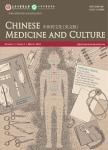Chinese Sources for AfterWards:From Premodern Poetry,Paintings,and Medical Texts to Modern Novels,Film,and Documentaries
French Sinologist, Canadian-born American Physiologist and the First English Translation of the Huangdi Neijing作者机构:Independent ScholarMax Planck Institute for the History of ScienceBerlin 14195Germany
出 版 物:《Chinese Medicine and Culture》 (中医药文化(英文))
年 卷 期:2023年第6卷第2期
页 面:127-138页
学科分类:0502[文学-外国语言文学] 050201[文学-英语语言文学] 05[文学]
基 金:supported by a Visiting Scholar Fellowship at Max Planck Institute for the History of Science Berlin
主 题:Documentaries Films Murals Narrative medicine Novels Paintings Poetry
摘 要:This paper focuses on Chinese sources suggested for a narrative medicine(NM)program,called AfterWards.Dr Lauren Small established AfterWards in 2014 and has been coordinating it since out of the Pediatrics Department at Johns Hopkins Medicine.In early 2019,she started giving a series of lectures and workshops about AfterWards to Chinese medical educators and clinicians in Beijing and Shanghai.She created an AfterWards Facilitator’s Guide based on Western-language sources for workshop participants.She also started to organize with Jiang Yuhong(Peking Union Medical College)a workshop for Chinese colleagues to be held at Johns Hopkins Medicine in October 2019.They invited the author to participate.The idea was hatched then to develop Chinese source materials following the AfterWards structure for an updated Facilitator’s Guide that Dr Small had initially written.A typical one-hour AfterWards session consists of a specific five-part structure:a literary text or artwork,an associated theme,discussion topics,a writing exercise,and shared reflection.While the content of the program always changes from session to session,the basic structure remains the same.This paper summarizes the types of Chinese sources and their related narrative-medicine themes that were originally selected for inclusion in the updated AfterWards Facilitator’s Guide intended for Chinese colleagues.These sources about coping with sick family members,aging,and illness ranged from the textual(classical Chinese poems on aging and diagnostic forms for training students)and visual(premodern Chinese paintings and murals of medical encounters)to the fictive(novels)and performative(contemporary Asian-American film in English and Chinese-language film and documentaries).



